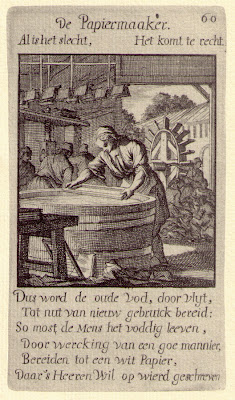 Lately, I've spent a lot of time in the Special Collections department at the University library as a part of my assistantship. For this research project, I 'm specifically looking for books from the 15th, 16th, and 17th centuries with paper that has aged either extremely well or extremely poorly. Surprisingly enough, I'm having a harder time finding books with bad paper, but I suppose the crummy stuff would've disintegrated by now. Most of the books I'm finding have beautiful, crisp white paper that look like they were pulled off the shelves of the paper store yesterday.
Lately, I've spent a lot of time in the Special Collections department at the University library as a part of my assistantship. For this research project, I 'm specifically looking for books from the 15th, 16th, and 17th centuries with paper that has aged either extremely well or extremely poorly. Surprisingly enough, I'm having a harder time finding books with bad paper, but I suppose the crummy stuff would've disintegrated by now. Most of the books I'm finding have beautiful, crisp white paper that look like they were pulled off the shelves of the paper store yesterday.
I'm humbled by the craftsmanship I see in these books, especially now that I know the steps it took to create each individual book, from making the paper, to printing the text, to the finished binding. Even the books that aren't particularly well crafted in today's standards represent an extraordinary assembly of men and women working together to create lasting works of knowledge and art.
My simple little books that once seemed like such big projects look like small beans in comparison. Still, I'm honored to play a role in the continuing legacy of the art and craft of hand printed, hand bound books.

(images borrowed from "Paper in Printing History" by the Lindenmeyr Paper Corporation)
